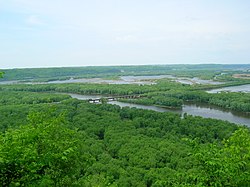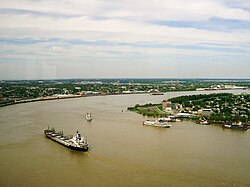Mississippi Valley
The Mississippi Valley is a place in North America. It is part of the Mississippi River watershed, meaning that the rain that falls in the Mississippi Valley flows to the Mississippi River.[1] It is in the middle of what is today the mainland United States.
Geology
During the last glacial era, large walls of ice dropped sediment, which is rocks and dirt, onto the land. This became sedimentary rock. This rock is softer than the other two main types of rock. Sedimentary rock forms in layers. When the Mississippi River began to flow, it washed away parts of the rock. So there are places in the northern valley with tall bluffs, places where the river water cut some of the rock away. People can see the layers in the bluffs. Some of them are 400 feet tall. In the places where the ground was made of harder sedimentary rock, for example limestone and dolomite, the cliffs are steep. In the places where the ground was made of softer sedimentary rock, for example shale and sandstone, the cliffs are gentle.[2]
Other parts of the Mississippi Valley are flood plain.
People
Many Native Americans lived in the Mississippi Valley, including the Mississippian culture, which is named after the valley. Many of these Native Americans practiced agriculture, meaning that they built farms and grew food.[1] Some of these Native Americans built large towns with earthworks and wooden fences and buildings. But many of them caught European diseases and died. By the time historians came to the towns, many of the buildings were gone.
The first Europeans to write about the Mississippi Valley was Hernando De Soto in 1541.[1]
The Mississippi Valley became part of the United States in 1803. This was the Louisiana Purchase.
Mississippi Valley Media
The source of the Mississippi River at Lake Itasca
The first bridge (and only log bridge) over the Mississippi, about 25 feet south of its source at Lake Itasca
Confluence of the Wisconsin and Mississippi rivers, viewed from Wyalusing State Park in Wisconsin
Barge on Upper Mississippi North of Lock and Dam No. 8
The confluence of the Mississippi (left) and Ohio (right) rivers at Cairo, Illinois, the demarcation between the Middle and the Lower Mississippi River
An animation of the flows along the rivers of the Mississippi watershed
References
- ↑ 1.0 1.1 1.2 "MISSISSIPPI VALLEY". Encyclopedia.com. Retrieved December 28, 2021.
- ↑ Thomas Madigan. "The Geology of the MNRRA Corridor". River of History. NPR. Retrieved December 28, 2021.






